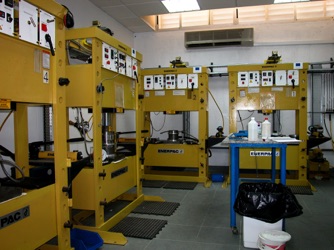Unidadad de Petrología Experimental
CSIC-Universidad de Huelva
Unidad Asociada adscrita al Instituto de Ciencias de la Tierra “Jaume Almera”, CSIC, Barcelona
Unidadad de Petrología Experimental
CSIC-Universidad de Huelva
Unidad Asociada adscrita al Instituto de Ciencias de la Tierra “Jaume Almera”, CSIC, Barcelona
Antonio Castro, University of Huelva, Spain
Determination of phase equilibria in magmatic systems
Determination of the mechanisms of fractionation and back-fractionation across thermal gradients in magma chambers
Partitioning of metals between melt and solid residues in silicic magmatic systems
Effects of pressure on mineral-melt partitioning in andesite magmas
Objectives of the
Experimental Unit

Technical data
Four end-loaded, internally heated piston-cylinder apparatus. Pressure vessels composed of steel rings and a core of ultra-hard material (CW). Internal diameter of 12.5 mm.
Cooling system: close circuit of water and cooling unit.
End load pressure: Commercial Enerpac® hydraulic system. Maximum oil pressure in the circuit 700 bar.
Conditions: Up to 1500 °C and 2.5 GPa.
Additional equipment: Vertical loading, high temperature furnace for the preparation of synthetic glasses.

Our new 4-WD spectrometer JEOL Superprobe. Fundamental for the study of experimental charges.



Alberto Patino-Douce, Hassan El-Hmdi and Antonio Castro setting up the first piston-cylinder experiment in Huelva in 1997. Alberto’s help was of great value during lab installation.
History & Funds
Equipment
The Experimental Unit nucleates over the Experimental Laboratory of the University of Huelva, after an extensive collaboration with the Volcanology team of the Jaume Almera Institute (CSIC, Barcelona) led by Prof. Joan Marti.
Along the last 15 years the Experimental Laboratory of Huelva, now Associate Unit CSIC-UHU, has produced 10 PhD Thesis and more than 40 research papers in SCI journals. Most of the equipment was acquired with FEDER funds from the European Union. The lab is funded with Research Grants from the Spanish Commission of Science and Technology and the Andalusian Government.
The Experimental Unit is formally approved in 2012 by signing of a protocol of collaboration among the two Institutions, the University of Huelva (UHU) and de Consejo Superior de Investigaciones Científicas (CSIC) by means of the Jaume Almera Institute.
The experimental laboratory of Huelva is the initial nucleus of the new Associate Experimental Unit. New projects and more intense collaboration between the two Institutions is expected in the future.
The first project has been the study of the El Hierro submarine eruption, in which the magmatic history and the relations between seismic signals and magmatic evolution has been established recently.
A co-ordinated project for three years (2011-2013), called PLUVOLC project, funded by the Spanish National Research Plan, is currently developed at present time. The project includes the study of large ignimbrite eruptions associated to caldera collapse and batholiths.
One of the most important experimental projects is the study of phase equilibria in silicic magma chambers feeding silicic volcanism
